Research Writing About Cultural Artifacts: (Softcover: $15, 106pp, 6X9”: ISBN: 978-1-68114-436-8; Hardcover: $30: ISBN: 978-1-68114-437-5; Ebook: $2.99: ISBN: 978-1-68114-438-2; LCCN: 2018906914; Edited by: Margaret Blatz; Release: October 22, 2018; Purchase on Amazon or Barnes & Noble): Research writing courses in colleges across the world have a tendency to be dull, and similar to each other. They typically review the elements of the research paper and ask students to draft formulaic papers that fit the set guidelines. There have been plenty of textbooks written for these classes that repeat nearly identical information. This market is definitely over-saturated. One alternative is a Research Writing class that focuses on audio-visual entertainment (such as film or music) and other cultural artifacts, as well as diversity-related topics. This class offers more engaging topics for research than the repeating political or social topics that fit the formula of a traditional college research writing class. Students are likely to be more interested in researching films they watch for fun than dusty topics they are not personally invested in. More colleges are likely to start teaching these types of classes especially with help from textbooks like this one that suits this curriculum. American students are reading less, and watching media more, a class that accepts this shift can embrace the students’ preferences, stimulating their imagination and desire to learn. This textbook combines the rigor of a Research Writing class with the imaginative and culturally significant realm of Cultural Studies. Concepts that are typically discussed in Research Writing textbooks, like close reading, thesis statement, and clichés, are covered in full. Complex rhetorical concepts are explained simply and fully. Additionally, the elements of a proper argument are not only digested for students, but are also assisted with discussions of political, economic, social and other types of cultural concepts such as communism or feminism. Teachers who are looking for ideas to inspire their plans, will find assignments across the book to utilize. This book is deliberately short and meant to be a cheap paperback, so that it can be utilized as a quick reference guide and idea book for cultural studies related topics (if not as the primary textbook for a course that entirely combines Research Writing with Cultural Studies).
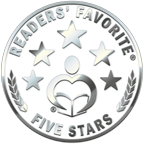
“Research Writing About Cultural Artifacts is a much-needed addition to the already crowded field of books about research writing. I think it is needed because it offers a less boring, more interesting approach. This is important because, in this day and age, the one thing that people will not tolerate is being bored. They also won’t tolerate their particular culture or voice being ignored. I love to read, but I can remember clearly how research writing took all the fun and excitement out of my thesis on Steinbeck and East of Eden. It is refreshing to see author Anna Faktorovich lay out a clear and logical alternative that will be just as factual and informative while at the same time being more interesting and inclusive. I applaud this. I write about Chinese history a lot myself. I want my books to be read by as many people as possible, so I want interesting ways to research my work and present it. Research Writing About Cultural Artifacts is laid out in a clear and logical format that is easy to read and makes perfectly good sense. The writing is great. It is somewhat scholarly but very accessible to the casual but educated reader. This book is full of a lot of new ideas and perspectives that I feel will eventually have a strong impact on future generations of students, scholars, and eventually even popular culture. I came to agree with a lot of her ideas and hope to implement them in future research and writing.” —***** Readers’ Favorite, Ray Simmons
“Classroom teachers who are looking for ideas to inspire their plans for students will find assignments they can easily incorporate into their instruction. Of special note is the commentary on ‘Concepts Involved in a Review’. Exceptionally well written, thoroughly ‘user friendly’ in organization and presentation, Research Writing About Cultural Artifacts is an ideal ‘how to’ reference for aspiring writers seeking to engage in research writing on any subject, in any genre, and for any publishing project.” –Library Bookwatch: The Writing/Publishing Shelf: February 2019: Midwest Book Review

Introduction to Literature: (Softcover: $20, 300pp, 6X9″: ISBN: 978-1-68114-442-9; Hardcover: $35: ISBN: 978-1-68114-443-6; Ebook: $2.99: ISBN: 978-1-68114-444-3; LCCN: 2018906964; Edited by: Rebecca Baird; Language Arts & Disciplines—Reading Skills; Release: October 22, 2018; Purchase on Amazon or Barnes & Noble): Within lies a shakeup of the traditional introductory literature course textbook formula, with a unique perspective on literature. You will find some theories that have not even been published in scholarly journals before, like the examination of the merchants’ language that Swift uses to disguise his meaning. Each of the sections on fiction, drama and poetry provides the most essential commentary, definitions and concepts. The readings include three short stories from Edgar Allan Poe, novel segments from Don Quixote, and Gulliver’s Travels, various poems, and a classic Greek play, Lysistrata. The uniting elements in these pieces are satire, sarcasm, and other forms of humor. This dense political, social and cultural content should inspire students with questions and a desire to write about it.

“Introduction to Literature is the second book I have reviewed by Anna Faktorovich. I anticipated reading it because I really enjoy her writing style. She is informative, humorous, and insightful. [It] is a book I wish I could have read in my freshman year in college, or at any point in my university experience. It is full of useful information about how to understand and comprehend literature. It gives us a lesson on literary criticism and some of the great masters of world literature. [It] is laid out in a neat and logical fashion. It starts with comprehending and writing about reading. It then moves on to types of literary criticism. It flows well and the writing, as all writing I have read by Anna Faktorovich, is superb. We move on to fiction terms and then there is a chapter on a giant of American fiction and one of my personal favorites, Mr. Edgar Allan Poe. This was my favorite chapter, but I admit that I also learned a lot in the chapters on Jonathan Swift and Miquel de Cervantes, with whom I am less familiar. Anna Faktorovich gave me new insights into these writers and their words, and I hope I can use this knowledge to develop my own literary abilities. All lovers of good books will appreciate and enjoy Introduction to Literature.” —***** Readers’ Favorite, Ray Simmons
“Introduction to Literature is a upper high school or early college-level textbook. The book has a section on fiction and poetry, each commenting with some vocabulary words, author biography and historical background. There are several well-known stories and authors included in the book such as Edgar Alan Poe, Rudyard Kipling and Walt Whitman. The end of each section provides discussion question and essay topics. ****” —LibraryThing Early Review, graduate student at Marshall University in Huntington, WV
 Radical Agrarian Economics: Wendell Berry and Beyond: ($20, ISBN: 978-1-937536-91-6, Hardcover ISBN: 978-1-68114-125-1, LCCN: 2014917270, 180pp, 6X9″, 7 photos, bibliography, index, February 4, 2015; Purchase on Amazon or Barnes and Noble): This is a comparative study of Wendell Berry’s theory of New Agrarian economics in contrast with other agrarian proposals, as well as communist, capitalist and feudal economic theories. The argument for an agrarian world has both similarities and sharp contrasts with Marxist communism, industrial capitalism, and classic feudalism. Agrarianism can be seen more clearly when it is contrasted and shown as having existed in parallel with each of these stages of economic world development. As the world quickly grows in the direction of overpopulation and pollution, a re-evaluation is needed of the previously used sustainability methods that have kept humanity in balance with the earth for millennia. As resources continue to become scarcer, those who can support themselves independently from mass-agricultural ventures might have a survival advantage. And this advantage should be explored before the world reaches a catastrophic phase. As the American farming population shrinks further below one percent of the overall population, this is a crucial moment to consider if agrarianism and agriculture itself should retain a central role in American political theory or if it should fade into the past.
Radical Agrarian Economics: Wendell Berry and Beyond: ($20, ISBN: 978-1-937536-91-6, Hardcover ISBN: 978-1-68114-125-1, LCCN: 2014917270, 180pp, 6X9″, 7 photos, bibliography, index, February 4, 2015; Purchase on Amazon or Barnes and Noble): This is a comparative study of Wendell Berry’s theory of New Agrarian economics in contrast with other agrarian proposals, as well as communist, capitalist and feudal economic theories. The argument for an agrarian world has both similarities and sharp contrasts with Marxist communism, industrial capitalism, and classic feudalism. Agrarianism can be seen more clearly when it is contrasted and shown as having existed in parallel with each of these stages of economic world development. As the world quickly grows in the direction of overpopulation and pollution, a re-evaluation is needed of the previously used sustainability methods that have kept humanity in balance with the earth for millennia. As resources continue to become scarcer, those who can support themselves independently from mass-agricultural ventures might have a survival advantage. And this advantage should be explored before the world reaches a catastrophic phase. As the American farming population shrinks further below one percent of the overall population, this is a crucial moment to consider if agrarianism and agriculture itself should retain a central role in American political theory or if it should fade into the past.
“In strikingly honest terms, Dr. Faktorovich shares a chastened and sincere study of a utopian economics envisioned by a poet of the natural world. With her concluding image of knitting as an act conjuring warmth, nostalgia and consolation, as well as reminding us of the haptic poetry of tactile work, she delivers with picturesque detail and a hint of melancholy, an answer that is deeply true.” —Catherine Corman, creator of photography collection, Daylight Noir
“I rate this book 4 out of 4 stars. It’s a concise, well-written, detailed work of economic history and theory that accomplishes its two goals of situating Wendell Berry and New Agrarianism in history, and considering the practicality of these ideas in the modern world. Faktorovich has indeed written a textbook for the student of agrarian economics, but she has done more: she has crafted an elegant and accessible history of economic thought. Her book is necessary for any reader of Wendell Berry, but also for thoughtful people from all disciplines with an interest in money, time, and the good life.” —OnlineBookClub.org
Gender Bias in Mystery and Romance Novel Publishing: Mimicking Masculinity and Femininity: ($20, 298pp, 7X10″, 67 illustrations and diagrams, bibliography, index, ISBN: 978-1-511888-90-5, EBook ISBN: 978-1-68114-093-3, LCCN: 2015939747, April 29, 2015; Purchase on Amazon, CreateSpace, or Barnes and Noble; or for $2.99 on Kindle or EBSCO): examines gender bias from the perspective of readers, writers and publishers, with a focus on the top two best-selling genres in modern fiction. It is a linguistic, literary stylistic, and structurally formalist analysis of the male and female “sentences” in the genres that have the greatest gender divide: romances and mysteries. The analysis will search for the historical roots that solidified what many think of today as a “natural” division. Virginia Woolf called it the fabricated “feminine sentence,” and other linguists have also identified clear sex-preferential differences in Anglo-American, Swedish and French novels. Do female mystery writers adopt a masculine voice when they write mysteries? Are female-penned mysteries structurally or linguistically different from their male competitors’, and vice versa among male romance writers? The first part can be used as a textbook for gender stylistics, as it provides an in-depth review of prior research. The second part is an analysis of the results of a survey on readers’ perception of gender in passages from literature. The last part is a linguistic and structural analysis of actual statistical differences between the novels in the two genres, considering the impact of the author’s gender.
“What makes this book unique from other authorities on the gender stylistics is that it includes an incredible amount of science – and not just theories that are convincing. With her great amount of expertise and work on the experiments she completes, we can truly believe that what she says is true, and not take what she says at face value. The unbiased and very professional writing of the book and intriguing conclusions and statements found within the book make this a worthwhile and spellbinding read for feminists, people interested in gender, readers and writers alike and those who have ever questioned the phrase, ‘Never judge a book by it’s cover.’ 4 out of 4 stars” —LiteraryMagic, OnlineBookClub, August, 2015
“Informed and informative, thoughtful and thought-provoking, Gender Bias in Mystery and Romance Novel Publishing is an inherently fascinating read which is strongly recommended to the attention of literary scholars and romance novel enthusiasts alike. Enhanced with the inclusion of a four page Glossary, a seven page listing of Works Cited, a seven page Index, and an eight page Appendix (Gender and Genre Survey), Gender Bias in Mystery and Romance Novel Publishing will prove of considerable interest to authors of romance fiction. Gender Bias in Mystery and Romance Novel Publishing is especially and highly recommended for academic library Literary Studies reference collections. It should be noted for personal reading lists that Gender Bias in Mystery and Romance Novel Publishing is available in a Kindle edition ($2.99).” —James A. Cox, Midwest Book Review, The Writing/Publishing Shelf, June 2015
“A must-read for a mystery author like me, but also for every man and woman interested in the way we interact because art mimics reality… Or is it just the opposite… 🙂 🙂 Original way to analyze gender bias in every aspect of life, via Mystery and Romance Novels. Very thoroughly researched. A wealth of knowledge and (educated) background for readers interested in this topic.” —Bob Van Laerhoven, winner of the Hercule Poirot Prize
“The data offered allows for concrete conclusions on questions gender linguists have been asking for several decades, such as the use of male active heroes and villains, but the diminishing of female characters to serve as passive victims or love interests in both popular romance and mystery genres.” —David R. Slavitt, author of more than 100 critically acclaimed books
Interview with Gothic Moms about Gender Bias, posted on May 15, 2015.
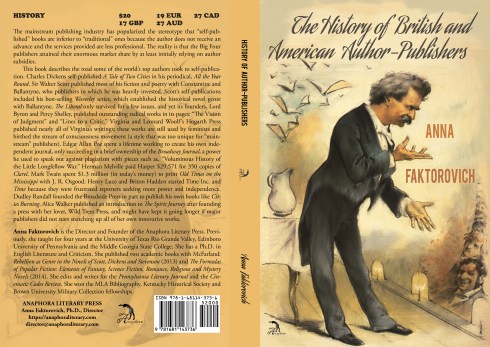
The History of British and American Author-Publishers: ($20, 368pp, 6X9”: Softcover: ISBN: 978-1-68114-373-6; $35: Hardcover: ISBN-13: 978-1-68114-374-3; $2.99: EBook: ISBN-13: 978-1-68114-375-0; LCCN: 2017950922; Edited by: Mallory Cormack; Includes bibliography and index; 11 illustrations; Biography & Autobiography—Editors, Journalists, Publishers; Release: January 5, 2018; Purchase on Amazon or Barnes & Noble): The mainstream publishing industry has popularized the stereotype that “self-published” books are inferior to “traditional” ones because the author does not receive an advance and the services provided are less professional. The reality is that the Big Four publishers attained their enormous market share by at least initially relying on author subsidies.
This book describes the road some of the world’s top authors took to self-publication. Charles Dickens self-published A Tale of Two Cities in his periodical, All the Year Round. Sir Walter Scott published most of his fiction and poetry with Constantine and Ballantyne, publishers in which he was heavily invested. Scott’s self-publications included his best-selling Waverley series, which established the historical novel genre with Ballantyne. The Liberal only survived for a few issues, and yet its founders, Lord Byron and Percy Shelley, published outstanding radical works in its pages: “The Vision of Judgment” and “Lines to a Critic.” Virginia and Leonard Woolf’s Hogarth Press published nearly all of Virginia’s writings; these works are still used by feminists and birthed the stream of consciousness movement (a style that was too unique for “mainstream” publishers). Edgar Allan Poe spent a lifetime working to create his own independent journal, only succeeding in a brief ownership of the Broadway Journal, a power he used to speak out against plagiarism with pieces such as, “Voluminous History of the Little Longfellow War.” Herman Melville paid Harper $29,571 for 350 copies of Clarel. Mark Twain spent $1.3 million (in today’s money) to print Old Times on the Mississippi with J. R. Osgood. Henry Luce and Briton Hadden started Time Inc. and Time because they were frustrated reporters seeking more power and independence. Dudley Randall founded the Broadside Press in part to publish his own books like Cities Burning. Alice Walker published an introduction to The Spirit Journey after founding a press with her lover, Wild Trees Press, and might have kept it going longer if major publishers did not start snatching up all of her own innovative full-length works.
Without author-publishers: the sun would still revolve around the earth (Galileo) and book printing would lack exquisite artistic details (Rembrandt). And Americans would still be living in the colonies of the United Kingdom (Benjamin Franklin). It is harder to find an innovative scientist, politician or creative writer who did not self-publish than those who did.
“A unique and extraordinary history of self-publishing that is impressively detailed, exceptionally informative, and ultimately inspiring, The History of British and American Author-Publishers is unreservedly recommended for both community and academic library Writing/Publishing collections, and is an inherently fascinating read from beginning to end. Simply stated, it should be on the personal reading list of every practicing or aspiring self-published author.” –Reviewer’s Bookwatch: Julie Summers’ Bookshelf: February 2019, Midwest Book Review
“If you are looking for a primer on the historical greats, advice on a thousand new non-fiction ‘must read’ topics to research on Wikipedia, or critical and solid advice on how to succeed via a non-conglomerate publishing avenue (by avoiding historic mistakes), you should look into snagging a copy of this. It is a bit depressing to identify with great authors by reading deep details of their pain and failures, but there is a degree of pity that once reached is actually quite inspiring.” —Toast Toasted, Jason Brown
“…Also ‘exhaustive,’ I’m afraid, is Faktorovich’s pursuit of her thesis about the challenges facing author-publishers over the past 250-or-so years… corrupt business practices, royal and political censorship, market control and cultivated contempt by what she labels ‘the Big Four’ publishing conglomerates, even the stuff of intrigue—the exhaustive part for me—suggesting the possibility of attempts to corrupt an individual’s mind/body/spirit through various practices, up-to-and-including assassination.” —“Added to my e-bookshelf… The History of British and American Author-Publishers”, Jeff McDonald, March 16, 2018, ArchaeoTexture
“I’d heard that Charles Dickens published A Tale of Two Cities as a series of magazine articles, but had not heard those were self-published. ‘It is harder to find an innovative scientist, politician or creative writer who did not self-publish than those who did…’ Well, that’s a bit dramatic, but certainly inspiring if true. I discourage young faculty members from self-publishing, as it means they haven’t looked very hard for a publisher. Still, your work is inspiring for people who want to write. I think we should encourage them to find a publisher sooner or later, or they’ll be viewed as beneath the dignity of even those who publish in the well-known ‘vanity presses.’” –Professor Frank A. Ward, College of Agricultural Sciences, New Mexico State University
“An invigorating plunge into the muddy sediment of history that supports the modern publishing industry. Faktorovich deftly explores the roots of artistic and marketplace tensions that continue to plague authors and publishers today… Also very helpful to students is Faktorovich’s primer (in the introduction) on proper definition and nomenclature in professional publishing. For example, the phrase ‘self-publishing’ is a vernacular faux pas that is best avoided in conversations on author-publishers. This book was absolutely delightful to read and one of the best ‘Early Reviewer’ volumes that I have had the privilege to enjoy! 5*” –Silver Quille, LibraryThing
Anna Faktorovich is the Director and Founder of the Anaphora Literary Press. Previously, she taught for over four years at the University of Texas Rio Grande Valley, Edinboro University of Pennsylvania and the Middle Georgia State College. She has a Ph.D. in English Literature and Criticism. She published two academic books with McFarland: Rebellion as Genre in the Novels of Scott, Dickens and Stevenson (2013) and The Formulas of Popular Fiction: Elements of Fantasy, Science Fiction, Romance, Religious and Mystery Novels (2014). She edits and writes for the Pennsylvania Literary Journal and the Cinematic Codes Review. She won the MLA Bibliography, Kentucky Historical Society and Brown University Military Collection fellowships.
Galley copies are available for review, email director@anaphoraliterary.com to request a free copy.
Book Trailer:

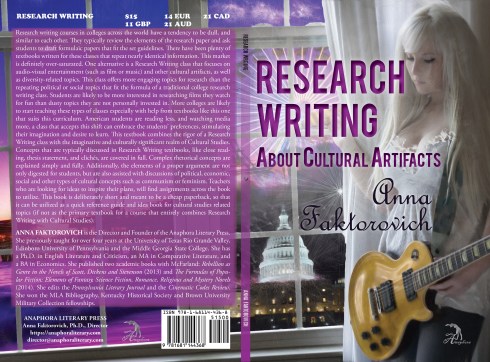


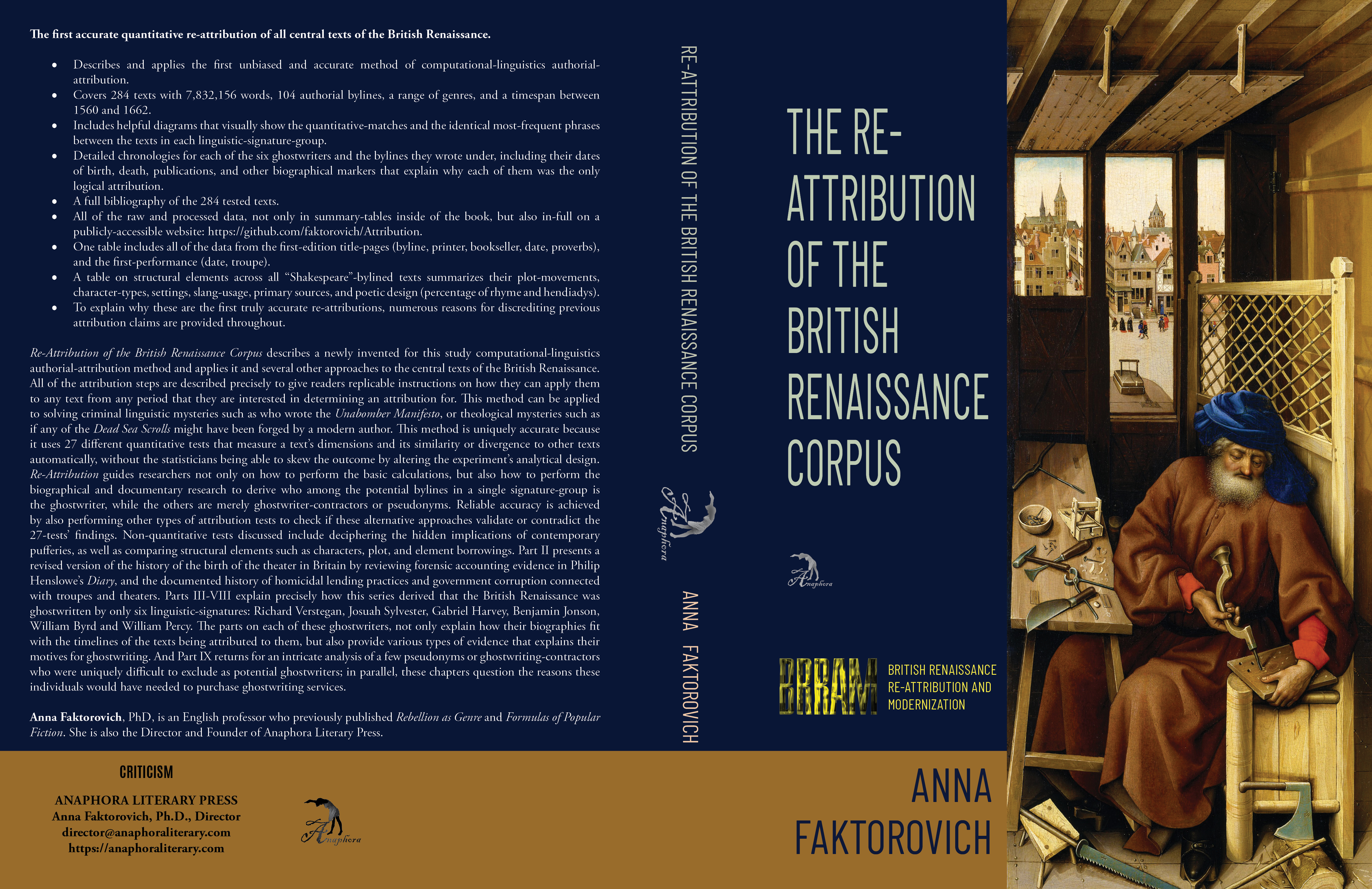
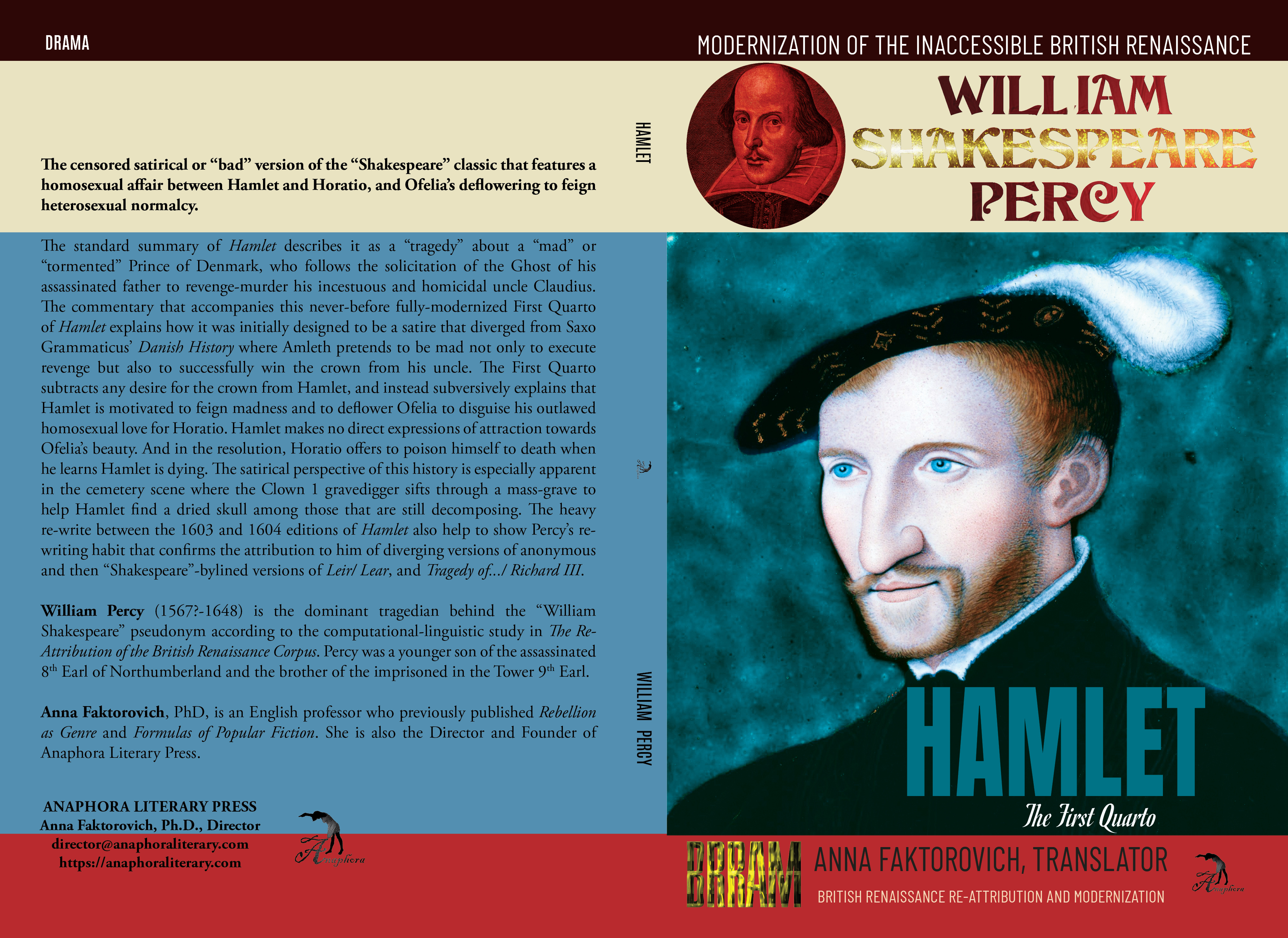
Leave a comment